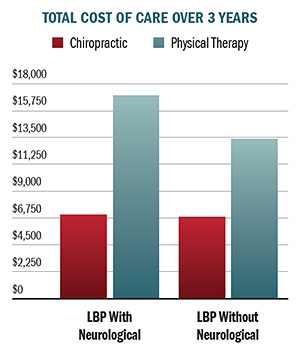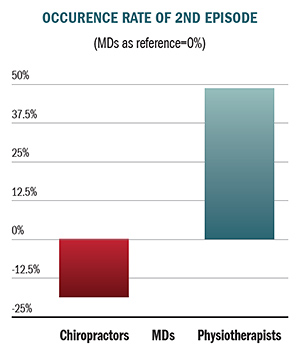You're at the annual conference of the North American Spine Society, sitting at a table with an insurance company medical director. She tells you she likes chiropractic care personally, but her company prefers PTs to deliver nonsurgical care for spine patient enrollees.
What is your response? First and foremost, you need to know that over the past decade, independent health care researchers have investigated the treatment effects of PTs and DCs.
Example #1
The first study was a cost-effective analysis of patients with low back pain that compared head-to-head the costs of physical therapists vs. the costs of chiropractors.1 This study assessed the medical records of 14,787 patients and was published in the Journal of the American College of Occupational and Environmental Medicine. The research team consisted of four PhDs, two PharmDs and one MD.
 Study participants were employees of a heavy equipment manufacturer who were mostly male, in their late 40s, and with an above-average middle-class income. Subjects were divided into two main categories, depending upon their presenting symptoms: low back pain with neurological symptoms and low back pain without neurological symptoms.
Study participants were employees of a heavy equipment manufacturer who were mostly male, in their late 40s, and with an above-average middle-class income. Subjects were divided into two main categories, depending upon their presenting symptoms: low back pain with neurological symptoms and low back pain without neurological symptoms.
Total costs, as defined for this study, included imaging, health care professional visits, medications, injections, surgery and disability payments.
The graph titled "Total Cost of Care Over 3 Years" tells a powerful story about the conclusions of this study. Total costs for low back pain patients with neurological findings were $6,983 for chiropractors vs. $17,194 for physical therapists. Total costs for low back pain patients without neurological findings were $6,768 for chiropractors vs. $13,449 for physical therapists. That is an enormous difference!
This study also examined why chiropractors are more cost-effective. It determined that chiropractors are less likely than physical therapists to recommend incongruent health care services for patients with low back pain, such as imaging, medications, injections and surgery.
Example #2
The second study examined the recurrence rate of back pain after a back injury among three types of health care providers: medical doctors (who served as the reference group), chiropractors and physiotherapists.2 The study was conducted by four PhDs and one Doctor of Science, and was published in the Journal of Occupational Rehabilitation. This research team analyzed data from a cohort of 5,511 workers with an initial episode of back injury.
 The graph titled "Occurrence Rate of 2nd Episode (MDs as reference=0%)" demonstrates the conclusions of this study. The type of health care provider first visited for back pain was a determinant of recurrence. Chiropractic patients experienced the fewest recurrences (-19 percent compared to MDs), while physiotherapy patients experienced the most (49 percent). These differences raise concerns regarding the use of physiotherapists as gatekeepers for spinal injuries.
The graph titled "Occurrence Rate of 2nd Episode (MDs as reference=0%)" demonstrates the conclusions of this study. The type of health care provider first visited for back pain was a determinant of recurrence. Chiropractic patients experienced the fewest recurrences (-19 percent compared to MDs), while physiotherapy patients experienced the most (49 percent). These differences raise concerns regarding the use of physiotherapists as gatekeepers for spinal injuries.
The Bottom Line
These two studies represent the tip of the research iceberg. There are more than two dozen studies that point in one direction: Chiropractic services are more economical than physiotherapist services, and chiropractors are more effective in the treatment of spinal conditions than physiotherapists.
Today, more than ever, current research needs to be on the tip of our tongues for issues relevant to our profession. You never know when an opportunity to influence may occur. Obviously, you should educate your patients about this research. Additionally, many medical practitioners are open to communications when those communications are evidence-based.
Author's Note: It's good to know the conclusions of relevant research; but if you really want to make an impression, you need to know the study details. You should know the journal name, the year the study was published, the composition of the research team, the sample size, general methods of the study and the conclusions.
References
- Allen H, Wright M, Craig T, et al. Tracking low back problems in a major self-insured workforce: toward improvement in the patient's journey. J Occup Environ Med, 2014;5:604-20.
- Blanchette MA, Rivard M, Dionne CE, et al. Association between the type of first healthcare provider and the duration of financial compensation for occupational back pain. J Occup Rehabil, 2017;27:382-392.
Click here for more information about Ronald Feise, DC.





